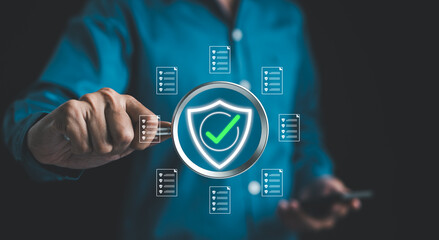Description
As our world becomes increasingly interconnected through digital technologies, the importance of cybersecurity has never been more pronounced. Cybersecurity threats pose significant risks not only to individuals but also to businesses, governments, and critical infrastructure. This comprehensive article explores the various types of cybersecurity threats, their implications, and strategies for protection in today’s digital landscape.
Introduction
In an era defined by rapid technological advancements, cybersecurity has emerged as a critical concern for organizations and individuals alike. Cyber threats are evolving in sophistication and frequency, targeting everything from personal data to national security. Understanding these threats and implementing effective cybersecurity measures is essential for safeguarding our digital lives.
This article will cover the following key areas:
- Understanding Cybersecurity
- Types of Cybersecurity Threats
- The Impact of Cybersecurity Threats
- Cybersecurity in Different Sectors
- Emerging Threats in the Digital Landscape
- Best Practices for Cybersecurity
- The Role of Government and Regulation
- Future Trends in Cybersecurity
- Case Studies of Major Cyber Attacks
- Conclusion: Building a Safer Digital Future
Understanding Cybersecurity
1. What is Cybersecurity?
Cybersecurity refers to the practice of protecting systems, networks, and data from digital attacks. It encompasses a wide range of technologies, processes, and practices designed to safeguard information from unauthorized access, theft, or damage.
2. The Importance of Cybersecurity
With the increasing reliance on digital technologies, the importance of cybersecurity cannot be overstated. Cyber attacks can lead to financial loss, reputational damage, and compromised sensitive information, impacting both individuals and organizations.
3. Key Concepts in Cybersecurity
- Confidentiality: Ensuring that sensitive information is accessible only to authorized individuals.
- Integrity: Maintaining the accuracy and reliability of data throughout its lifecycle.
- Availability: Ensuring that information and resources are accessible to authorized users when needed.
Types of Cybersecurity Threats
1. Malware
Malware, or malicious software, is designed to disrupt, damage, or gain unauthorized access to computer systems. Common forms of malware include:
- Viruses: Self-replicating programs that attach to legitimate files.
- Worms: Standalone malware that replicates itself to spread across networks.
- Trojan Horses: Malicious software disguised as legitimate applications.
2. Phishing Attacks
Phishing involves tricking individuals into providing personal information by impersonating a trustworthy source. Techniques include:
- Email Phishing: Sending fraudulent emails that appear legitimate.
- Spear Phishing: Targeting specific individuals or organizations with personalized attacks.
3. Ransomware
Ransomware is a type of malware that encrypts a victim’s files and demands payment for their release. High-profile attacks have targeted hospitals, municipalities, and corporations, causing significant disruptions.
4. Denial-of-Service (DoS) Attacks
DoS attacks overwhelm a system with traffic, rendering it unavailable to legitimate users. Distributed Denial-of-Service (DDoS) attacks use multiple compromised systems to launch a coordinated assault.
5. Man-in-the-Middle (MitM) Attacks
MitM attacks occur when an attacker intercepts communication between two parties. This can lead to data theft, eavesdropping, and unauthorized access to sensitive information.
6. Insider Threats
Insider threats arise from individuals within an organization who misuse their access to information systems. These threats can be intentional (malicious) or unintentional (negligent).
7. IoT Vulnerabilities
The proliferation of Internet of Things (IoT) devices creates new opportunities for cybercriminals. Many IoT devices lack robust security measures, making them susceptible to attacks.
The Impact of Cybersecurity Threats
1. Financial Consequences
Cyber attacks can result in significant financial losses for organizations, including costs related to recovery, legal fees, and reputational damage. The global cost of cybercrime is projected to reach trillions of dollars annually.
2. Reputation Damage
A cybersecurity breach can severely damage an organization’s reputation, leading to a loss of trust among customers and stakeholders. Rebuilding reputation can take years and require significant investment.
3. Legal and Regulatory Ramifications
Organizations may face legal consequences following a data breach, including fines, lawsuits, and regulatory scrutiny. Compliance with data protection regulations, such as GDPR, is essential for mitigating risk.
4. Operational Disruption
Cyber attacks can disrupt business operations, leading to downtime and loss of productivity. This impact can be particularly severe for critical infrastructure sectors, such as healthcare and finance.
Cybersecurity in Different Sectors
1. Healthcare
The healthcare sector is a prime target for cybercriminals due to the sensitive nature of patient data. Cyber attacks can disrupt patient care, compromise personal information, and lead to significant financial losses.
2. Finance
Financial institutions face constant threats from cybercriminals seeking to steal money or sensitive information. Robust cybersecurity measures are essential to protect against fraud and data breaches.
3. Government
Government agencies are frequent targets of cyber attacks, with threats ranging from espionage to ransomware. Securing sensitive data and maintaining public confidence are critical challenges for government cybersecurity.
4. Education
Educational institutions are increasingly targeted by cyber attacks as they store large amounts of personal data. Phishing attacks and ransomware are common threats in this sector.
5. Critical Infrastructure
Critical infrastructure sectors, such as energy, water, and transportation, are vulnerable to cyber threats that can disrupt services and pose national security risks.
Emerging Threats in the Digital Landscape
1. AI-Powered Attacks
As artificial intelligence (AI) technology advances, cybercriminals are leveraging AI to enhance their attacks. AI can automate phishing campaigns, analyze vulnerabilities, and create sophisticated malware.
2. Supply Chain Attacks
Supply chain attacks target vulnerabilities in third-party vendors and partners to gain access to larger organizations. These attacks can be difficult to detect and mitigate.
3. Quantum Computing Threats
Quantum computing has the potential to break existing encryption methods, posing a significant threat to cybersecurity. Organizations must begin preparing for the implications of quantum computing on data protection.
4. Deepfakes and Misinformation
Deepfake technology can be used to create realistic but fake videos and audio recordings, posing risks for misinformation campaigns and reputational damage.
Best Practices for Cybersecurity
1. Implementing Strong Password Policies
Encouraging the use of complex passwords and implementing multi-factor authentication can significantly enhance security and reduce the risk of unauthorized access.
2. Regular Software Updates
Keeping software and systems up to date is essential for protecting against known vulnerabilities. Regular updates can patch security flaws and strengthen defenses.
3. Employee Training and Awareness
Training employees on cybersecurity best practices and raising awareness about common threats, such as phishing, can help create a culture of security within organizations.
4. Data Encryption
Encrypting sensitive data adds an additional layer of protection, making it more difficult for attackers to access and exploit information.
5. Incident Response Planning
Developing and testing an incident response plan ensures that organizations can respond effectively to cyber incidents, minimizing damage and recovery time.
The Role of Government and Regulation
1. Cybersecurity Frameworks
Governments and organizations can adopt cybersecurity frameworks, such as the NIST Cybersecurity Framework, to establish best practices and improve overall cybersecurity posture.
2. Public-Private Partnerships
Collaboration between government agencies and private sector organizations can enhance information sharing and improve collective cybersecurity efforts.
3. Legislation and Compliance
Governments may enact legislation to enforce cybersecurity standards and protect sensitive data. Compliance with regulations, such as the Health Insurance Portability and Accountability Act (HIPAA) and GDPR, is crucial.
4. Cybersecurity Awareness Campaigns
Government-led awareness campaigns can educate the public about cybersecurity threats and promote safe online behavior.
Future Trends in Cybersecurity
1. Increased Focus on Privacy
As concerns about data privacy grow, organizations will need to prioritize protecting personal information and comply with evolving regulations.
2. Zero Trust Architecture
The zero trust security model advocates for strict access controls and verification for users, regardless of their location, to minimize the risk of insider threats and data breaches.
3. Automation and AI in Cybersecurity
The use of AI and machine learning will continue to grow in cybersecurity, enabling organizations to detect threats more efficiently and respond in real-time.
4. Enhanced Threat Intelligence
Organizations will increasingly rely on threat intelligence to anticipate and mitigate potential cyber threats, leveraging data analytics and machine learning.
Case Studies of Major Cyber Attacks
1. WannaCry Ransomware Attack
In 2017, the WannaCry ransomware attack affected thousands of organizations worldwide, encrypting data and demanding ransom payments. The attack highlighted vulnerabilities in outdated systems and the importance of timely software updates.
2. Equifax Data Breach
The Equifax data breach in 2017 exposed the personal information of approximately 147 million consumers. The incident underscored the critical need for robust cybersecurity measures and regulatory compliance.
3. SolarWinds Supply Chain Attack
The SolarWinds cyber attack in 2020 involved a sophisticated supply chain compromise that affected numerous government and private sector organizations. The attack highlighted the vulnerabilities in third-party software and the need for enhanced security measures.
4. Colonial Pipeline Ransomware Attack
In 2021, a ransomware attack on Colonial Pipeline disrupted fuel supplies across the eastern United States. The incident raised awareness about the vulnerabilities in critical infrastructure and the potential consequences of cyber attacks.
Conclusion: Building a Safer Digital Future
The landscape of cybersecurity threats is ever-evolving, posing significant challenges for individuals, organizations, and governments. As we continue to embrace digital technologies, it is imperative to prioritize cybersecurity and implement effective measures to protect sensitive information and critical infrastructure.
By understanding the various types of cyber threats, staying informed about emerging risks, and adopting best practices, we can work towards creating a safer digital world. Collaboration between the public and private sectors, along with ongoing education and awareness, will be key to addressing the complex challenges of cybersecurity in the years to come. Together, we can build a resilient digital future that safeguards our data, privacy, and security.




